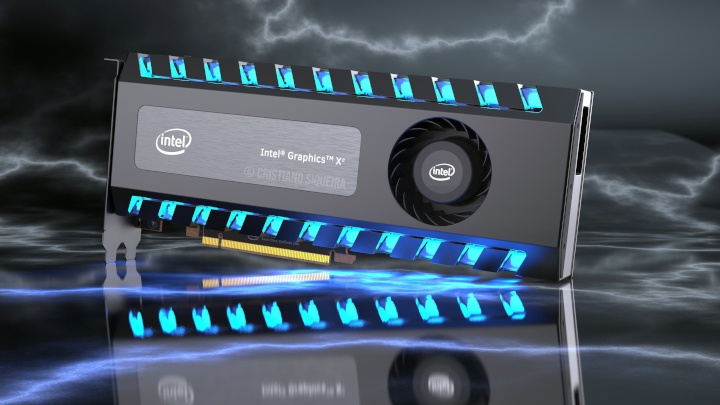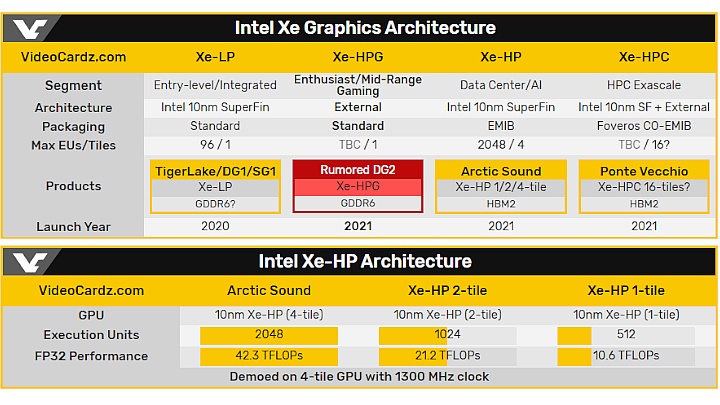The First Top-shelf Gaming GPUs From Intel in 2021
The first Intel GPU based on Xe-HP/HPG chipsets will appear in 2021. Their goal is a demanding gaming market. A new competitor will appear in a space dominated by AMD and Nvidia.

- Xe-HPG cards are to win Intel a place in the gaming segment;
- The likely performance of Intel Xe-HP chipsets in the 4-tile version is 42.3 TFlop;
- The launch of new Intel GPUs is planned for 2021.
Intel intends to join the fight for demanding players. AMD and Nvidia GPU manufacturers may soon gain a new rival. All thanks to high-performance Xe-HP and Xe-HPG GPUs. Intel's first high-performance graphics cards will support hardware ray tracing and launch in 2021 (source: VideoCardz).
Nvidia is preparing for the release of Ampere cards, AMD is working on RDNA 2. Will Intel's Xe-HPG chipsets have a fighting chance against them in the market? It seems that the company from Santa Clara wants to at least try. The first performance information looks quite promising.
Intel Xe-HP/HPG/HPC chipsets are to be tiled. A single 1.3Ghz clocked chip is to contain 512 computing units, and its computing power will be just over 10 TFlops. Depending on the version, the whole chipset will consist of 1, 2 or 4 such chips (tiles). Although some leaks say that Xe-HPC can have up to 16 tiles.

In the case of the Intel Xe-HP chipset, designed for the Data Center segment, in the 4-tile version (2048 computing units), the computing power can be as high as over 42 TFlops (with FP32 precision, RTX 3080 Ti is expected to reach 19.7 TFlops). The GPU is to be manufactured in Intel's 10 nm SuperFin architecture and work with HBM2 memory.
Xe-HPG graphics cards target the gaming segment. They are designed to support GDDR6 memory, but not much is known about the architecture (although 10 nm lithography can be expected). It is also unclear what "tile" versions can be made. There's talk of a basic one chip version, but we hope we will also be able to choose from stronger varieties that could actually be an alternative to RTX 3080 or RTX 3080 Ti cards. New GPUs are supposed to offer hardware ray tracing, just like Nvidia's Turing cards and AMD's RDNA 2.
In terms of power consumption, the base layout (1 chip) is expected to consume 150 watts. The stronger 2 and 4 Tiles (Xe-HP) are 300 W and 400/500 W respectively (it is not known in which system). If a 2-chip version of Xe-HPG is created, it will not be too far behind the competition in terms of energy consumption (RTX 3080 Ti is to have a TDP of 320 W). All this, including performance, will be verified after the release. We hope that in some time, when buying a GPU, apart from "red" and "green", "blue" will also be a sensible choice.
- Baldur's Gate 3 publisher explains confusion with Divinity: Original Sin 3. We know what Larian is definitely not working on
- PS Plus: Two more bonus games for December 2025 have been announced. One of them is Assassin's Creed: Mirage
- The Witcher 3 gets a new DLC after 10 years? „Biggest source” confirms
0

Author: Arkadiusz Strzala
His adventure in writing began with his own blog and contributing to one of the early forums (in the olden days of Wireless Application Protocol). An electrical engineer by profession, he has a passion for technology, constructing and, of course, playing computer games. He has been a newsman and writer for Gamepressure since April 2020. He specializes in energy and space tech. However, he does not shy away from more relaxed matters every now and then. He loves watching science-fiction movies and car channels on YouTube. He mainly plays on the PC, although he has modest console experience too. He prefers real-time strategies, FPS and all sorts of simulators.
Latest News
- End of remote work and 60 hours a week. Demo of Naughty Dog's new game was born amid a crunch atmosphere
- She's the new Lara Croft, but she still lives in fear. Trauma after Perfect Dark changed the actress' approach to the industry
- „A lot has become lost in translation.” Swen Vincke suggests that the scandal surrounding Divinity is a big misunderstanding
- Stuck in development limbo for years, ARK 2 is now planned for 2028
- Few people know about it, but it's an RPG mixing Dark Souls and NieR that has received excellent reviews on Steam, and its first DLC will be released soon

